Trees Birds Mammals Fish Amphibians Reptiles
Wild Algarve
Bookshop
Lactarius deterrimus Gröger - False Saffron Milkcap
Phylum: Basidiomycota - Class: Agaricomycetes - Order: Russulales - Family: Russulaceae
Distribution - Taxonomic History - Etymology - Identification - Culinary Notes - Reference Sources
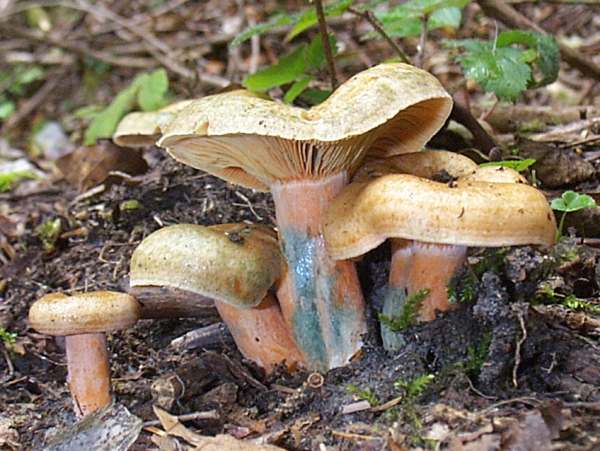
Lactarius deterrimus is a large milkcap with
carrot-coloured gills and greenish tints as it matures. A distinctive
feature is the latex ('milk) exuded from cut or torn gills, which changes from carrot-orange to dark
red as it dries.
Common in coniferous woodland, this large and conspicuous mushroom favours
spruce and pine habitats; it is also known as the Spruce Milkcap because it so often occurs in spruce plantations, particularly on acidic soil.
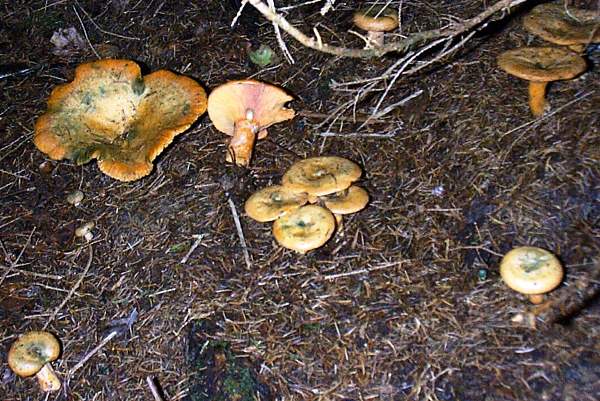
Distribution
Widespread and common throughout Britain and Ireland, the False Saffron Milkcap is also found in most parts of mainland Europe. Very similar milkcaps occur in North America but they may turn out not to be co-specific with the European species Lactarius deterrimus.
Occurring only under conifers and nearly always in spruce woodlands, this
is a mushroom that can carpet large areas of forest floor.
The green clouding on caps of Lactarius deterrimus is often present
even in very young specimens.
Taxonomic history
This mushroom was first validly described in 1968 by German mycologist Frieder Gröger, who gave it the scientific name Lactarius deterrimus by which it is still generally referred to today.
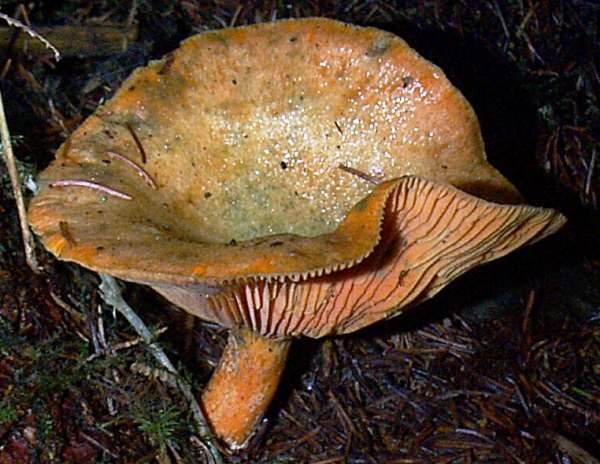
Of course, such a meaty milkcap had not gone unnoticed for centuries; but prior to 1968 this milkcap had been regarded not as a species in its own right but merely a variety of the Saffron Milkcap Lactarius deliciosus, and it was known by the scientific name Lactarius deliciosus var. piceus because of its mycorrhizal association with spruce trees (Picea species).
Etymology
The generic name Lactarius means producing milk (lactating) - a reference to the milky latex that is exuded from the gills of milkcap fungi when they are cut or torn.
The specific epithet deterrimus comes from Latin and means 'the least good' (in other words, the worst!) - a reference to the low culinary value of this common milkcap (althought not everyone would agree that this is a fair assessment).
Identification guide
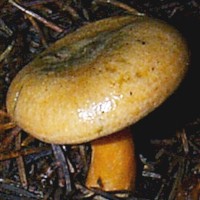 |
Cap
6 to 12cm in diameter, convex and then
depressed, the cap is yellowish orange zoned with darker areas and nearly
always with irregular green patches. Bruised areas also turn greenish.
Mature specimens often develop sharp-edged irregular wavy margins and usually turn greener in the centre and is blotches elsewhere on the cap surface. |
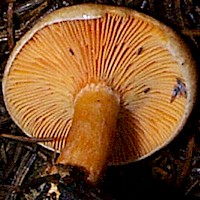 |
Gills
Shortly decurrent, crowded, bright orange,
staining green when bruised, the gills release orange latex that
turns wine red within 30 minutes and eventually dark green.
Stem
5 to 10cm long and 8 to 12mm in diameter, the stem surface is smooth and,
unlike Lactarius deliciosus, not pitted. There is usually a somewhat
paler band near to the top of the stem. |
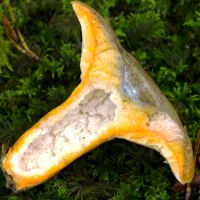 |
The stems of mature specimens are hollow. |
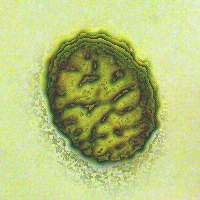 |
Spores
Subglobose to ellipsoidal, 7.5-10 x 6-7.6µm; ornamented with warts up to 0.5µm tall joined by lines to form an incomplete network.
Spore print
Pale pinkish buff. |
Odour/taste |
Slightly fruity smell; the milk (latex) is bitter and
acrid (in contrast to Lactarius deliciosus which releases a mild-tasting latex). |
Habitat & Ecological role |
Mycorrhizal, in conifer woodland, particularly spruce plantations. |
Season |
August to October in Britain and Ireland; several weeks later in southern Europe. |
Similar species |
Lactarius torminosus is more pink, has a woolly cap margin
and is always close to birch trees.
Lactarius deliciosus has a pitted stem and green areas on the
cap only in older specimens. |
Culinary Notes
Its specific epithet indicates that this large milkcap is one of the poorest of esculents, at least when assessed against other large orange milkcap species. Even when cooked well, these somewhatvariable (in terms of flavour) mushrooms often retain a bitter taste that not everyone would enjoy.
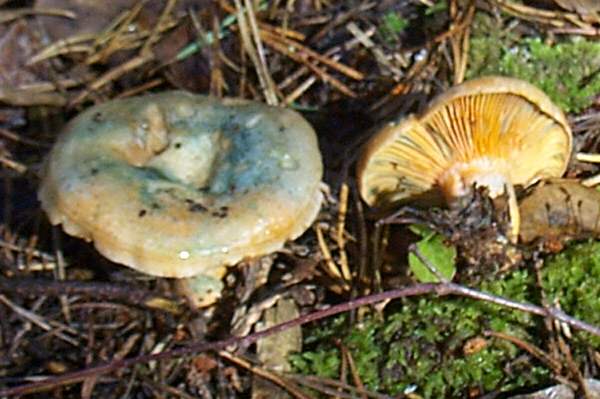
Reference Sources
Fascinated by Fungi, 2nd Edition, Pat O'Reilly 2016, reprinted by Coch-y-bonddu Books in 2022.
Funga Nordica, Henning Knudsen and Jan Vesterholt, 2008.
Fungi of Switzerland, volume 6: Russulaceae, Kränzlin, F.
BMS List of English Names for Fungi.
Dictionary of the Fungi; Paul M. Kirk, Paul F. Cannon, David W. Minter and J. A. Stalpers; CABI, 2008
Taxonomic history and synonym information on these pages is drawn from many sources but in particular from the British Mycological Society's GB Checklist of Fungi.
Top of page...
Fascinated by Fungi. Back by popular demand, Pat O'Reilly's best-selling 450-page hardback book is available now. The latest second edition was republished with a sparkling new cover design in September 2022 by Coch-y-Bonddu Books. Full details and copies are available from the publisher's online bookshop...